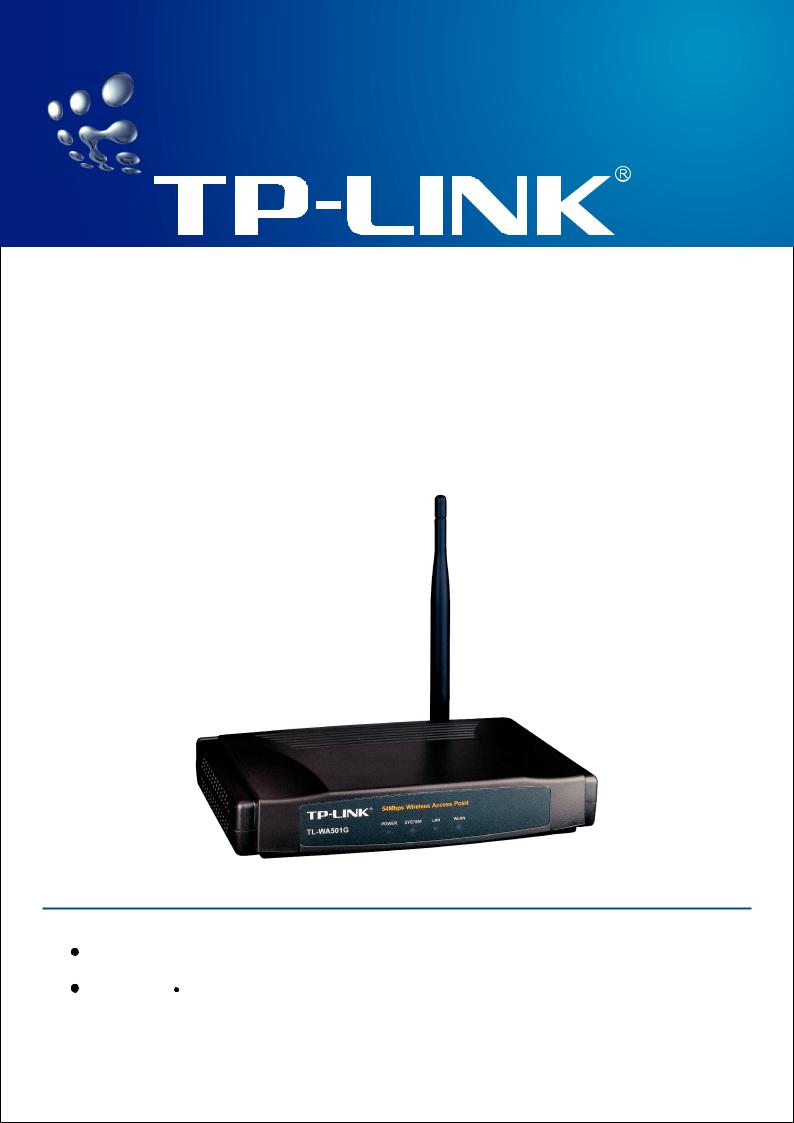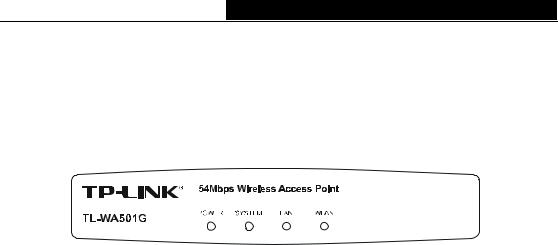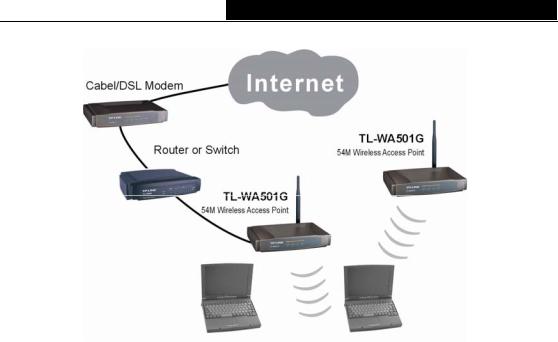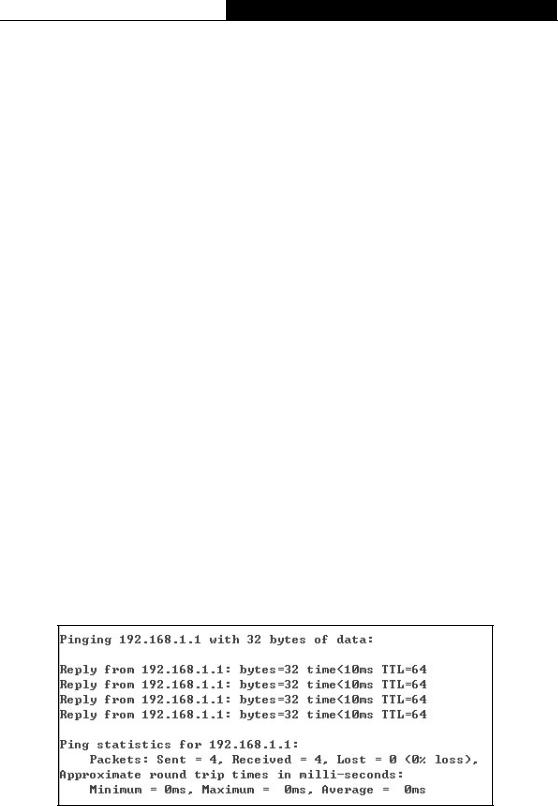TP-Link TL-WA501G User Manual 2

User Guide |
TL-WA501G |
54Mbps Wireless Access Point |
2x to 3x eXtended RangeTM |
2.4GHz 802.11g/b |

COPYRIGHT & TRADEMARKS
Specifications are subject to change without notice.  is a registered trademark of TP-LINK Technologies Co., Ltd. Other brands and product names are trademarks or registered trademarks of their respective holders.
is a registered trademark of TP-LINK Technologies Co., Ltd. Other brands and product names are trademarks or registered trademarks of their respective holders.
No part of the specifications may be reproduced in any form or by any means or used to make any derivative such as translation, transformation, or adaptation without permission from TP-LINK Technologies Co., Ltd. Copyright © 2006 TP-LINK Technologies Co., Ltd. All rights reserved.

FCC STATEMENT
This equipment has been tested and found to comply with the limits for a class B digital device, pursuant to part 15 of the FCC Rules. These limits are designed to provide reasonable protection against harmful interference in a residential installation.
This equipment generates, uses and can radiate radio frequency energy and, if not installed and used in accordance with the instructions, may cause harmful interference to radio communications. However, there is no guarantee that interference will not occur in a particular installation. If this equipment does cause harmful interference to radio or television reception, which can be determined by turning the equipment off and on, the user is encouraged to try to correct the interference by one or more of the following measures:
¾Reorient or relocate the receiving antenna.
¾Increase the separation between the equipment and receiver.
¾Connect the equipment into an outlet on a circuit different from that to which the receiver is connected.
¾Consult the dealer or an experienced radio/TV technician for help.
This device complies with Part 15 of the FCC Rules. Operation is subject to the following two conditions:
(1)This device may not cause harmful interference.
(2)This device must accept any interference received, including interference that may cause undesired operation.
Changes or modifications to this unit not expressly approved by the party responsible for compliance could void the user's authority to operate the equipment.
FCC RF Radiation Exposure Statement:
This equipment complies with FCC RF radiation exposure limits set forth for an uncontrolled environment. This device and its antenna must not be co-located or operating in conjunction with any other antenna or transmitter.
“To comply with FCC RF exposure compliance requirements, the antenna used for this transmitter must be installed to provide a separation distance of at least 20 cm from all persons and must not be co-located or operating in conjunction with any other antenna or transmitter”.
CE Declaration of Conformity
For the following equipment: TL-WA501G
Is herewith confirmed to comply with the requirements set out in the Council Directive on the Approximation of the Laws of the Member States relating to Electromagnetic Compatibility (89/336/EEC), Low-voltage Directive (73/23/EEC) and the Amendment Directive (93/68/EEC), the procedures given in European Council Directive 99/5/EC and 89/3360EEC.
The equipment was passed. The test was performed according to the following European standards:
¾EN 300 328 V.1.4.1 (2003)
¾EN 301 489-1 V.1.4.1 (2002) / EN 301 489-17 V.1.2.1 (2002)
¾EN 60950-1: 2001
¾EN 55022: 1998 + A1: 2000 + A2: 2003
¾EN61000-3-2:2001
¾EN61000-3-3:2001
¾EN 55024: 1998 +A1: 2001 + A2: 2003
European standards dictate maximum radiated transmit power of 100mW EIRP and frequency range 2.400-2.4835GHz; In France, the equipment must be restricted to the 2.4465-2.4835GHz frequency range and must be restricted to indoor use.
Package contents.............................................................................................................. |
1 |
|
Chapter 1: About this Guide .............................................................................................. |
2 |
|
1.1 |
Purposes.............................................................................................................. |
2 |
1.2 |
Conventions ......................................................................................................... |
2 |
1.3 |
Overview of this User Guide ................................................................................ |
2 |
Chapter 2: Introduction...................................................................................................... |
3 |
|
2.1 |
Overview of the AP .............................................................................................. |
3 |
2.2 |
Features............................................................................................................... |
3 |
2.3 |
Panel Layout ........................................................................................................ |
4 |
|
2.3.1 The Front Panel ......................................................................................... |
4 |
|
2.3.2 The Rear Panel.......................................................................................... |
4 |
Chapter 3: Connecting the AP........................................................................................... |
6 |
|
3.1 |
System Requirements.......................................................................................... |
6 |
3.2 |
Installation Environment Requirements................................................................ |
6 |
3.3 |
Connecting the AP ............................................................................................... |
6 |
Chapter 4: TCP/IP Configuration....................................................................................... |
8 |
|
Chapter 5: Configuring the AP ........................................................................................ |
10 |
|
5.1 login ................................................................................................................... |
10 |
|
5.2 |
Status................................................................................................................. |
10 |
5.3 |
Network............................................................................................................... |
11 |
5.4 |
Wireless ............................................................................................................. |
12 |
|
5.4.1 Basic Settings .......................................................................................... |
12 |
|
5.4.2 Security Settings...................................................................................... |
17 |
|
5.4.3 MAC Filtering ........................................................................................... |
19 |
|
5.4.4 Wireless Statistics .................................................................................... |
21 |
5.5 DHCP................................................................................................................. |
22 |
|
|
5.5.1 DHCP Settings......................................................................................... |
22 |
|
5.5.2 DHCP Clients List .................................................................................... |
23 |
|
5.5.3 Address Reservation................................................................................ |
23 |
5.6 |
Wireless Advanced Settings............................................................................... |
24 |
5.7 |
System Tools...................................................................................................... |
25 |
|
5.7.1 Firmware.................................................................................................. |
25 |
|
5.7.2 Factory Defaults....................................................................................... |
26 |
|
5.7.3 Reboot ..................................................................................................... |
26 |
|
5.7.4 Password ................................................................................................. |
27 |
|
5.7.5 Log........................................................................................................... |
27 |
Appendix A: FAQ............................................................................................................. |
29 |
|
Appendix B: Configuring the PCs.................................................................................... |
30 |
|
Appendix C: Specifications.............................................................................................. |
35 |
|
Appendix D: Glossary ..................................................................................................... |
36 |
|
Appendix E: Contact Information..................................................................................... |
38 |
|

TL-WA501G 54M Wireless Access Point User Guide
Package contents
The following contents should be found in your box:
¾One TL-WA501G 54Mbps Wireless Access Point
¾One AC power Adapter for TL-WA501G 54Mbps Wireless Access Point
¾One Resource CD for TL-WA501G 54Mbps Wireless Access Point, including:
•This Guide
•Other Helpful Information
¾Wall-mounting screws
Note: If any of the listed contents are damaged or missing, please contact the retailer from whom you purchased the TL-WA501G 54Mbps Wireless Access Point for assistance.
- 1 -

TL-WA501G 54M Wireless Access Point User Guide
Chapter 1: About this Guide
Thank you for choosing the TL-WA501G 54Mbps Wireless Access Point. This AP provides connectivity between Ethernet wired networks and radio-equipped wireless devices. It adopts 2x to 3x eXtended RangeTM WLAN transmission technology so that transmission distance is 2-3 times of traditional IEEE 802.11g/b solutions, up to 855.36m tested in China. Transmission range is extended to 4-9 times.
It is an easy, web-based setup for installation and management. Even though you may not be familiar with the AP, this guide will make configuring the AP easy. Before installing the AP, please look through this guide to get to know all the AP’s functions.
1.1 Purposes
This Guide tells you how to use the TL-WA501G 54Mbps Wireless Access Point.
1.2 Conventions
The AP mentioned in this guide stands for TL-WA501G 54Mbps Wireless Access Point.
1.3 Overview of this User Guide
Chapter 1: About this Guide
Chapter 2: Introduction
Chapter 3: Connecting the AP
Chapter 4: TCP/IP Configuration
Chapter 5: Configuring the AP
Appendix A: FAQ
Appendix B: Configuring the PCs
Appendix C: Specifications
Appendix D: Glossary
Appendix E: Contact Information
- 2 -

TL-WA501G 54M Wireless Access Point User Guide
Chapter 2: Introduction
2.1 Overview of the AP
The TL-WA501G 54Mbps Wireless Access Point is the basic building block of a wireless LAN infrastructure. It provides connectivity between Ethernet wired networks and radio-equipped wireless notebook systems, desktop systems, print servers, and other devices.
The TL-WA501G 54Mbps Wireless Access Point acts as a bridge between the wired LAN and wireless clients. Connecting multiple TL-WA501G Access Points via a wired Ethernet backbone can further lengthen the wireless network coverage. As a mobile computing device moves out of the range of one access point, it moves into the range of another. As a result, wireless clients can freely roam from one Access Point to another and still maintain seamless connection to the network.
In the most attentive wireless security, the TL-WA501G 54Mbps Wireless Access Point provides multiple protection measures. It can be set to turn off wireless network name (SSID) broadcast so that only stations that have the SSID can be connected. The AP provides wireless LAN 64/128/152-bit WEP encryption security, and WPA/WPA2 and WPA-PSK/WPA2-PSK authentication, as well as TKIP/AES encryption security. It also supports VPN pass-through for sensitive data secure transmission.
The TL-WA501G 54Mbps Wireless Access Point complies with the IEEE 802.11g/b standards so that the data transmission rate is up to 54Mbps. It adopts 2x to 3x eXtended RangeTM WLAN transmission technology so that transmission distance is 2-3 times of traditional IEEE 802.11g/b solutions, up to a distance of 855.36m tested in China. Transmission range is extended to 4-9 times. It is compatible with all IEEE 802.11g and IEEE 802.11b products.
2.2 Features
¾Complies with IEEE802.11g, IEEE802.11b, IEEE802.3, IEEE802.3u standards
¾Adopts 2x to 3x eXtended RangeTM WLAN transmission technologies
¾Supports 54/48/36/24/18/12/9/6Mbps or 11/5.5/3/2/1Mbps wireless LAN data transfer rates
¾Provides 64/128/152-bit WEP encryption security
¾Provides WPA/WPA2 and WPA-PSK/WPA2-PSK authentication and TKIP/AES encryption security
¾Built-in DHCP server supporting dynamic IP address distributing
¾Supports MAC address filtering
¾Supports multiple operating modes (Access Point, Client, Repeater, Point to Point, Point to Multi-point)
¾Supports TCP/IP, DHCP, SNMP
¾Supports Traffic statistics
¾Supports firmware upgrade
¾Supports Remote and Web management
-3 -

TL-WA501G 54M Wireless Access Point User Guide
2.3 Panel Layout
2.3.1 The Front Panel
Viewed from left to right, as shown in figure 2-1, the front panel of the TL-WA501G consists of four LEDs, which is designed to indicate connections. Table 2-1 describes the LEDs on the front panel of the AP.
|
|
|
Figure 2-1: Front Panel sketch |
|
|
|
|
Name |
Action |
|
Description |
POWER |
Not lit |
|
No Power |
Lit up |
|
Power on |
|
|
|
||
|
Lit up |
|
The AP is initialising |
SYSTEM |
Flashing |
|
The AP is working properly |
|
Not lit |
|
The AP has a hardware error |
|
Not lit |
|
There is no device linked to the corresponding port |
LAN |
Lit up |
|
There is a device linked to the corresponding port but no |
|
activity |
||
|
|
|
|
|
Flashing |
|
There is an active device linked to the corresponding port |
WLAN |
Not lit |
|
The Wireless Radio function is disabled |
Flashing |
|
The Wireless Radio function is enabled |
|
|
|
||
|
|
Table 2-1 The LEDs description |
|
2.3.2 The Rear Panel
The rear panel contains the following features: (Viewed from left to right in figure 2-2)
¾Wireless antenna
¾Factory Default Reset button
¾There are two ways to reset the AP's factory defaults:
1)Use the Factory Defaults function on System Tools -> Factory Defaults page in the AP's Web-based Utility.
2)Use the Factory Default Reset button: First, turn off the AP's power. Second, press and hold the default reset button then turn on the AP's power, until the system LED lights up (about 3 seconds). Last, release the reset button and wait for the AP to reboot.
Note: Ensure the AP is powered on before it restarts completely.
¾One LAN 10/100Mbps RJ45 port for connecting the AP to hub or switch
¾AC power socket: only use the power adapter supplied with the TL-WA501G 54Mbps Wireless Access Point, use of a different adapter may result in product damage.
-4 -

TL-WA501G 54M Wireless Access Point User Guide
Figure 2-2: Rear Panel sketch
- 5 -

TL-WA501G 54M Wireless Access Point User Guide
Chapter 3: Connecting the AP
3.1 System Requirements
¾Broadband Internet Access Service (DSL/Cable/Ethernet)
¾One DSL/Cable Modem that has an RJ45 connector
¾A Ethernet broadband router
¾TCP/IP protocol must be installed on each PC
¾Web browser, such as Microsoft Internet Explorer 5.0 or later, Netscape Navigator 6.0 or later
¾802.11g or 802.11b-compliant devices, such as the TL-WN510G Wireless Adapter
3.2 Installation Environment Requirements
¾Not in direct sunlight or near a heater or heating vent
¾Not cluttered or crowded. There should be at least 2 inches (5 cm) of clear space on all sides of the AP
¾Well ventilated (especially if it is in a closet)
¾Operating temperature: 0 ~40 (32 ~104 )
¾Operating Humidity: 10%~90%RH, Non-condensing
3.3 Connecting the AP
Figure 3.1 is an example of an infrastructure network incorporating the TL-WA501G. An Infrastructure network contains an access point or a wireless router. For a typical connection of the AP, please do the following:
1.You will need broadband Internet access (a Cable or DSL-subscriber line into your home or office). Consult with your Cable or DSL provider for proper installation of the modem.
2.Connect the Cable or DSL modem to a Router. Quickly install the router.
3.Locate an optimum location for the AP. The best place is usually near the center of the area in which your PC(s) will wirelessly connect. The place must accord with the Installation Environment Requirements.
4.Adjust the direction of the antenna. Normally, upright is a good direction.
5.Connect the Ethernet Broadband Router to the TL-WA501G AP. Power on the AP.
6.If you are connecting a desktop PC or laptop to your network, install the TP-LINK Wireless Adapter on the PC.
- 6 -

TL-WA501G 54M Wireless Access Point User Guide
Figure 3-1 The Example of Infrastructure Network Incorporating the TL-WA501G
- 7 -

TL-WA501G 54M Wireless Access Point User Guide
Chapter 4: TCP/IP Configuration
After connecting the TL-WA501G AP into your network, you should configure it. The default IP address of the TL-WA501G 54Mbps Wireless Access Point is 192.168.1.1, and the default Subnet Mask is 255.255.255.0. These values can be seen from the LAN. They can be changed as you desire, as an example we use the default values for description in this guide.
Connect the local PCs to the LAN ports on the AP. There are then two means to configure the IP address for your PCs.
¾Configure the IP address manually
1)Set up the TCP/IP Protocol for your PC(s). If you need instructions as to how to do this, please refer to Appendix B: "Configuring the PCs."
2)Configure the network parameters. The IP address is 192.168.1.xxx ("xxx" is from 2 to 254), Subnet Mask is 255.255.255.0, and Gateway is 192.168.1.1 (The AP's default IP address)
¾Obtain an IP address automatically
1)Set up the TCP/IP Protocol in "Obtain an IP address automatically" mode on your PC(s). If you need instructions as to how to do this, please refer to Appendix B: "Configuring the PCs."
2)Power off the AP and PC(s). Then turn on the AP, and restart the PC(s). The built-in DHCP server will assign IP addresses for the PC(s).
Now, you can run the Ping command in the command prompt to verify the network connection between your PC(s) and the AP. The following example is in Windows 2000 OS.
Open a command prompt, and type ping 192.168.1.1, then press Enter.
Figure 4-1: Successful result of Ping command
If the result displayed is similar to that shown in figure 4-1, the connection between your PC and the AP has been established.
- 8 -
